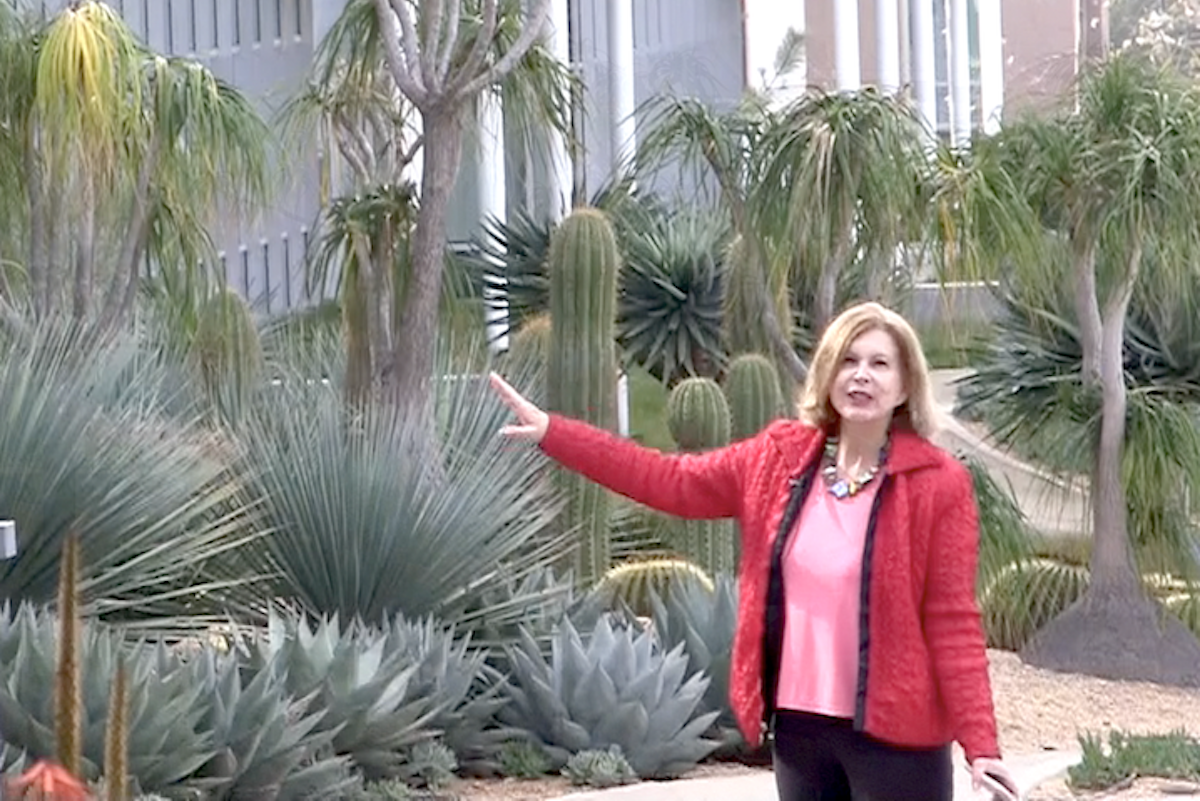
Critique: Newport Beach’s Grand Succulent Garden
Planning to design, revamp or evaluate a succulent landscape? Discover what I like and what dismays me about Newport Beach’s grand Civic Center succulent garden. It’s large-scale, but its plusses and minuses apply to waterwise gardens of any size.
Opened in 2013, the Newport Beach Civic Center graces a coastal community of homes with an average value of $2,000,000. The complex cost $140 million and is a masterpiece of modern architecture within sight of the Pacific. Overlapping, S-shaped awnings atop a series of sleek buildings suggest ocean waves. The multi-acre succulent garden along the complex’s north side is a public park.
It has a nice layout, with wide, serpentine paths that invite strolling and rolling (everything from baby carriages to wheelchairs). There are multiple plantings of large specimens—Dracaena draco, Aloe bainesii, Beaucarnea recurvata and columnar cacti. These likely were mature at installation in order to be in scale with their setting, and doubtless were craned-in at no small expense. Filler plants include agaves, dasylirions, aloes, puyas (a succulent bromeliad), golden barrels, aeoniums, Senecio mandraliscae, and silver-leaved Cotyledon orbiculata. Warm-toned gravel enhances the design, holds moisture in the soil, inhibits weed growth, and lends visual continuity. In light of the fact that structures across the street have water-thirsty lawns and tightly pruned shrubs (landscaping that doesn’t make sense on so many levels), what’s not to love?
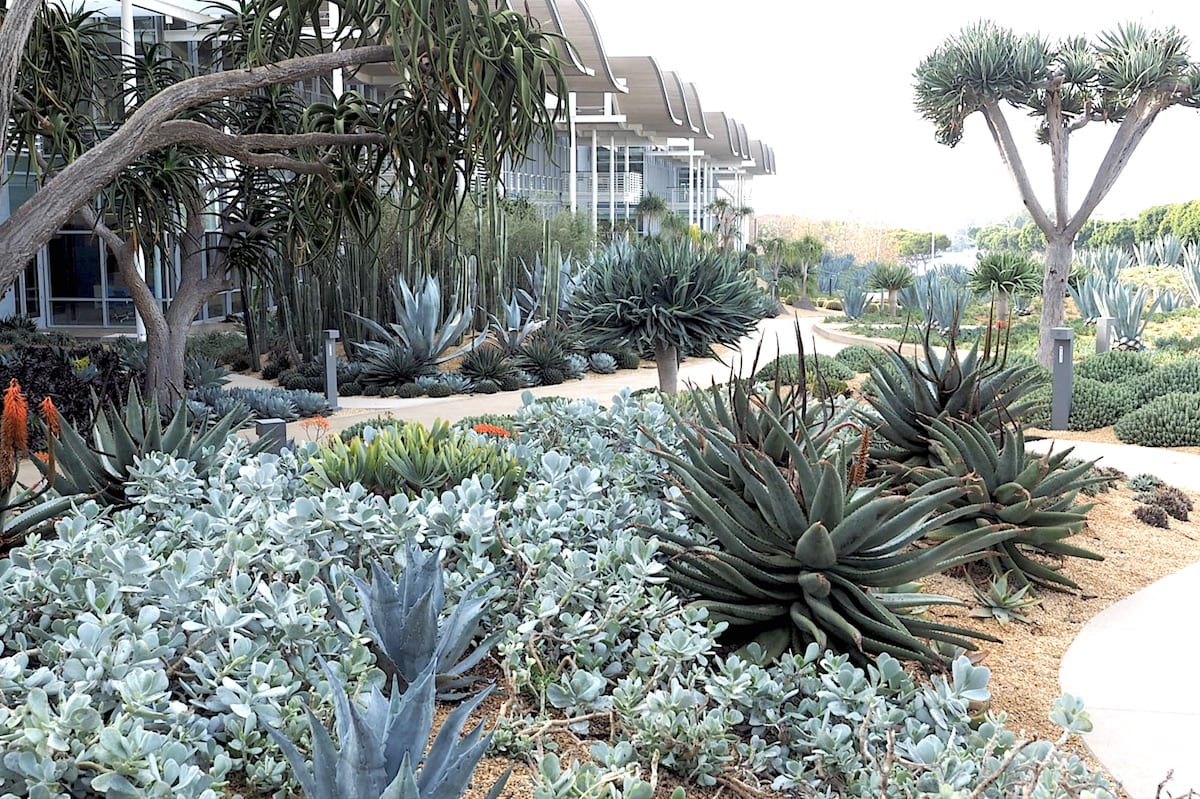
Silver and blue succulents dominate the Newport Beach Civic Center garden
Highly toxic euphorbia
Well, Euphorbia resinifera for one thing. I like the mounding growth habit of this African succulent, which suggests a short-spined cactus consisting of squarish, columnar green stems. It grows slowly into ever-expanding colonies. However, this cool-looking plant is quite hot…and not in a good way.
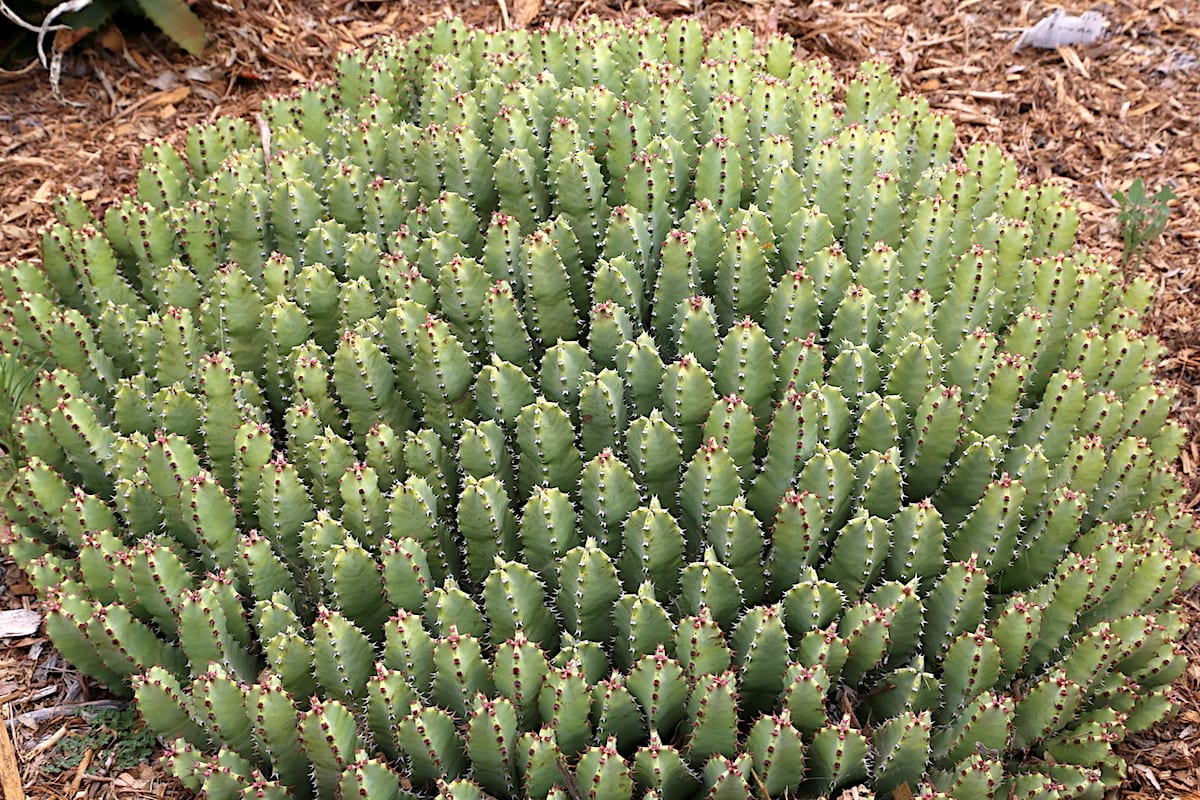
Euphorbia resinifera has short, sharp spines and—typical of the genus—milky sap.
Its milky, resinous sap contains resiniferatoxin, which is similar to capsaicin in peppers but a thousand times hotter. On the Scoville scale, resiniferatoxin ranks at 16 billion units, 4.5 million times hotter than a jalapeno. So if the sap should enter an open wound or eye, the sensation would be like a blow torch. Of course that’s only possible when Euphorbia resinifera grows where someone could fall on it, break its stems, and get scratched by its thorns…like along the downward curve of a pathway in a public garden frequented by kids on scooters, skates and bikes.
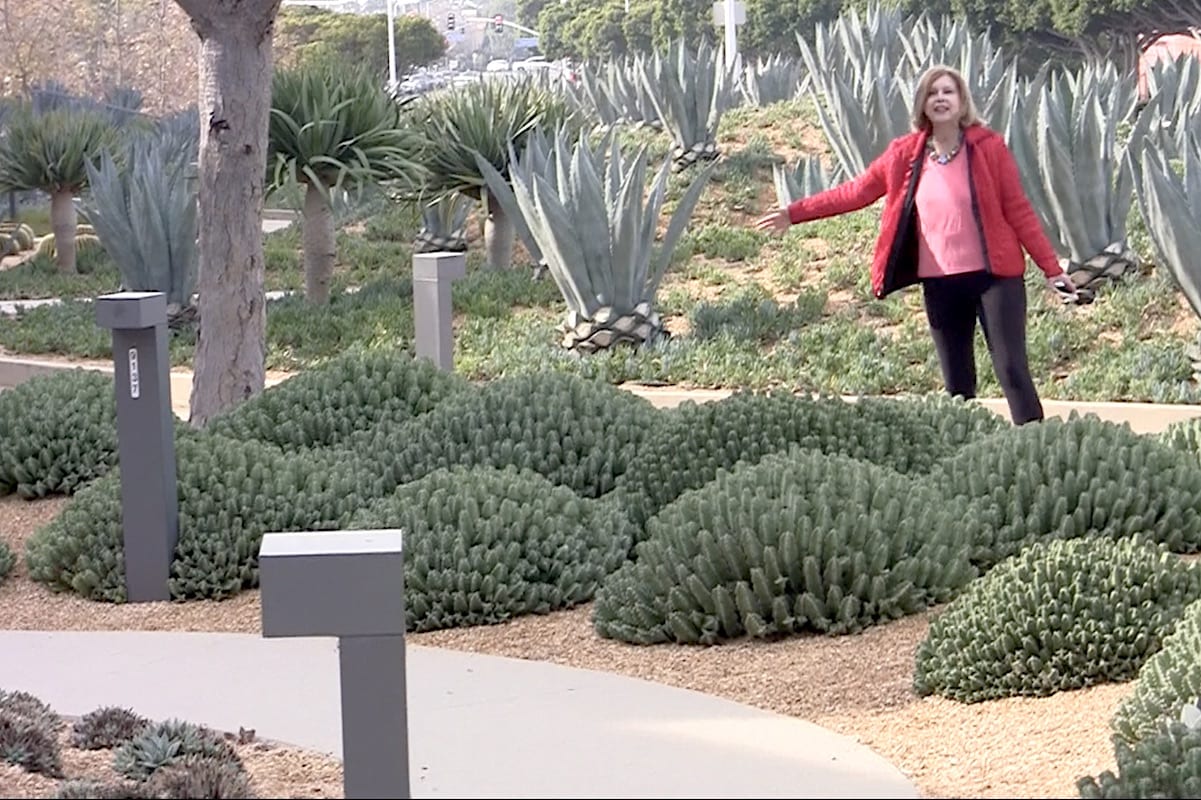
Adding a curb would create a barrier that keeps kids from careening into Euphorbia resinifera.
A missed opportunity
Another succulent in the garden, prickly pear cactus (Opuntia sp.), is far from pathways…no surprise, because it’s obviously unfriendly.
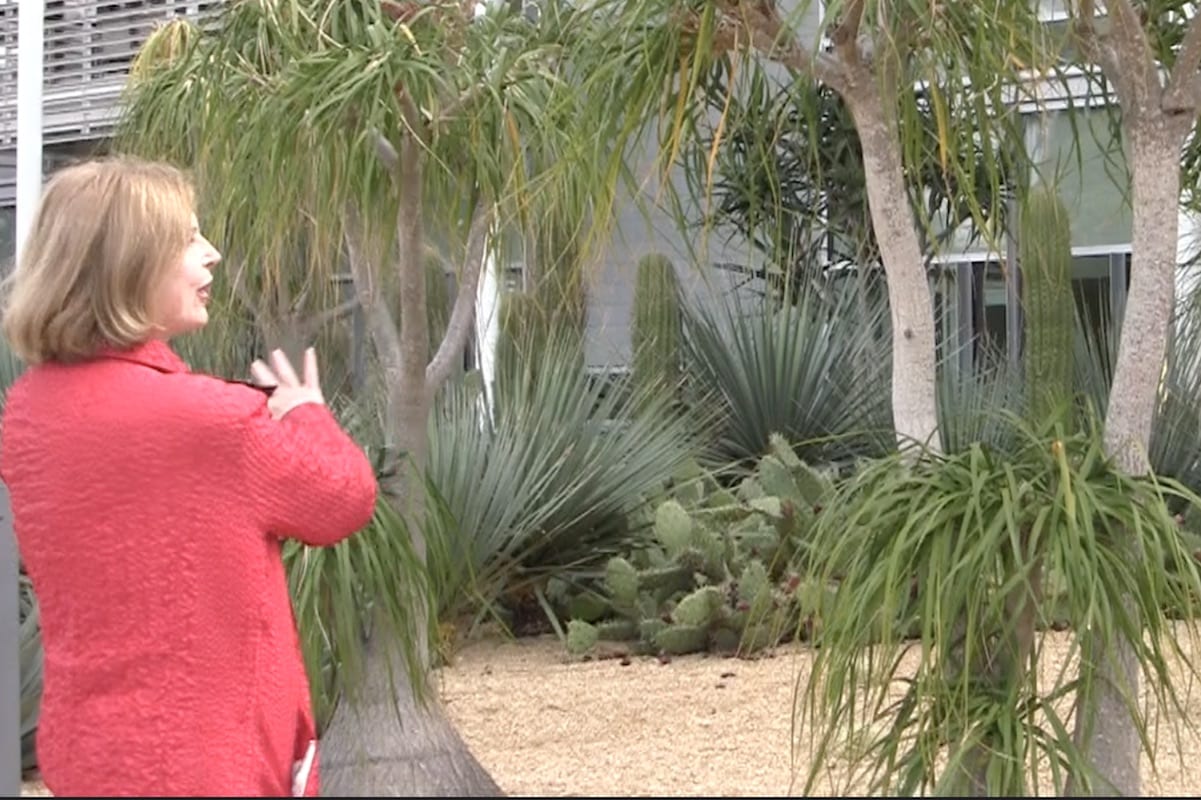
Prickly pear cactus (lower center) grows well away from foot traffic.
Yet Opuntia species that lack spines are nowhere to be found, and they would have been suitable anywhere. Opuntia cacanapa ‘Ellisiana’, shown below at a nursery, grows tall (upwards of 6 feet), offers a pleasing silhouette of ever-branching ovals, forms a sculptural green backdrop, starts readily from cuttings, gets by on rainfall alone, and is entirely harmless.
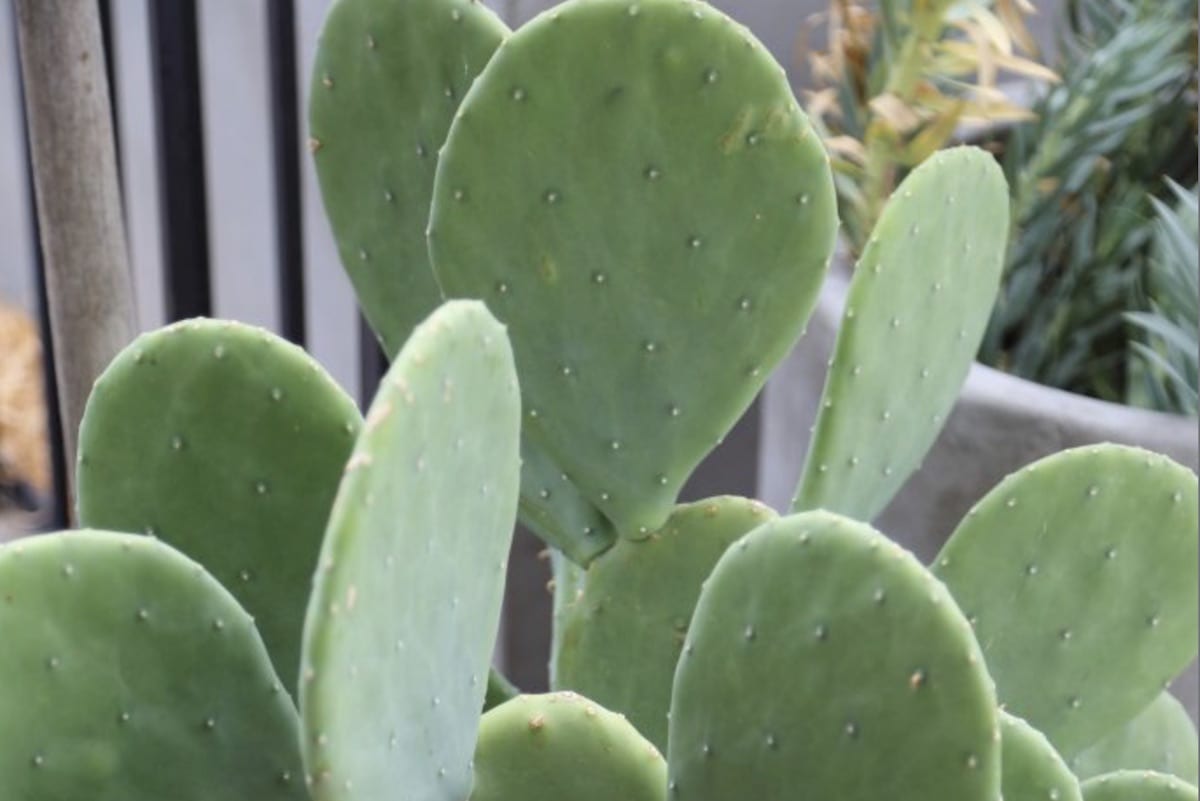
Spineless paddle cactus would have been a good alternative
Silver swords and serrated leaves
Spare-no-expense plants such as Puya venusta (a succulent bromeliad) and Cleistocactus strausii (a fuzzy columnar cactus) blend together in a surreal, silvery harmony of starbursts and snowy poles. But IMHO they’re a bit too texturally inviting to be at toddler-level.

Silver swords combine with bromeliads near Civic Center windows. From my video: “Newport Beach’s Grand Succulent Garden” Note the truncated Puya venusta, center.
Yes, of course, parents should teach children not to touch unfamiliar plants, especially any that are spiny, thorny, toothed or bristly. But what about plants that touch kids? Over time, the puyas have become crowded and some, seeking light, have grown horizontally. One had to be cut back from the pathway. Doing so destroyed the plant’s symmetry and bloom potential.
I also wonder if the area that this silver grouping occupies—north-facing, close to the building and beneath its wavy eaves—is sunny enough for puyas to bloom. After all, that’s what they’re known for: eye-catching, truly-blue flowers.
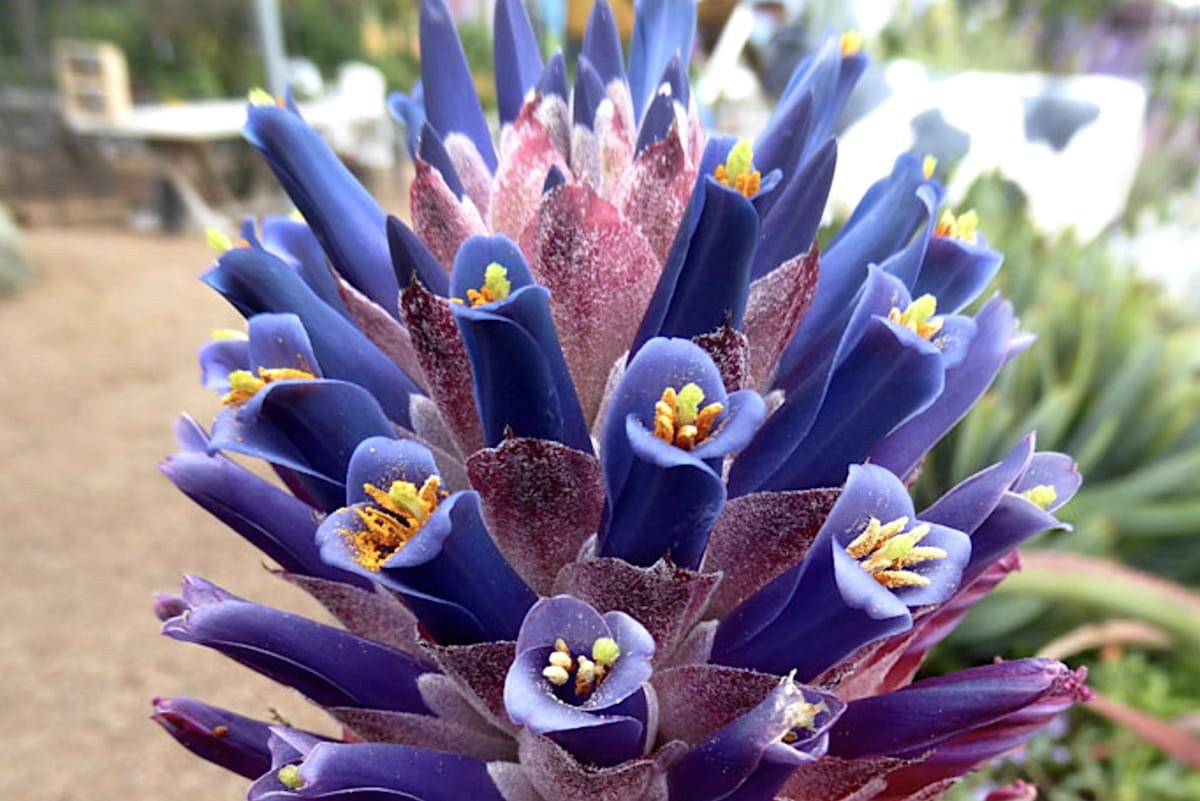
Big silver puyas bloom blue (shown at Annie's Annuals nursery).
Best-ever beaucarneas
On the plus side, the garden showcases how to mound and topdress soil, use planted islands, and how just a few sculptural succulents can create an intriguing, low-maintenance, low-water landscape.
This is best illustrated by a grouping of Beaucarnea recurvata. (Its common names “ponytail palm,” “elephant’s foot palm” and “bottle palm” are misleading—these tree succulents aren’t palms.) Like many agaves and cacti also in the garden, beaucarneas are from Mexico. They’re easy to come by, inexpensive even in 5-gallon pots, grow fairly rapidly when in the ground (about a foot a year), tolerate mild frosts, and have intriguing Dr. Seuss-like forms. What makes each “succulent” is its bulbous, water-storing base (caudex). In summer, the trees’ topknots produce feathery sprays of cream and pink.
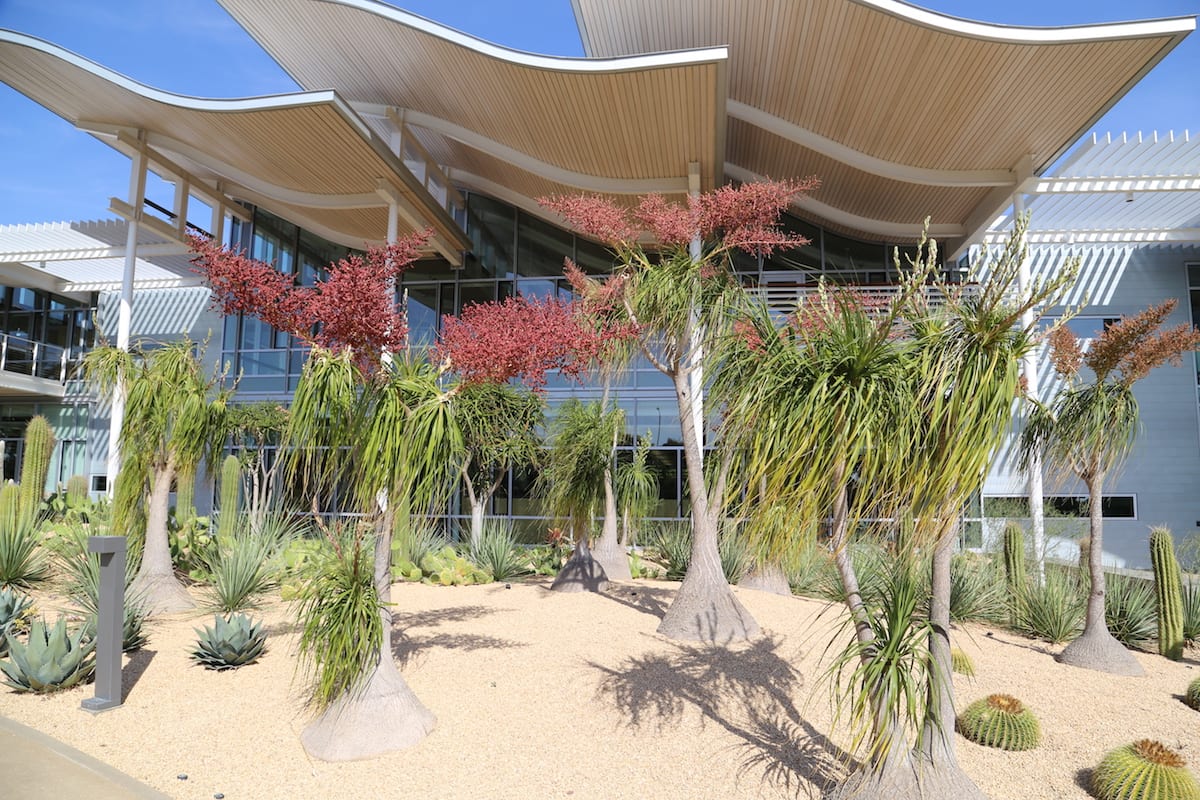
Beaucarnea recurvata in bloom
Out-of-control agaves
But the most perplexing aspects of the garden are its rows of century plants (Agave americana) that occupy large beds between walkways and street. I suspect that what must have seemed brilliantly economical six years ago has become a maintenance problem. Though quite common and often free for the asking, century plants eventually get as big as Volkswagens and produce numerous offsets (“pups”) from shallow roots.
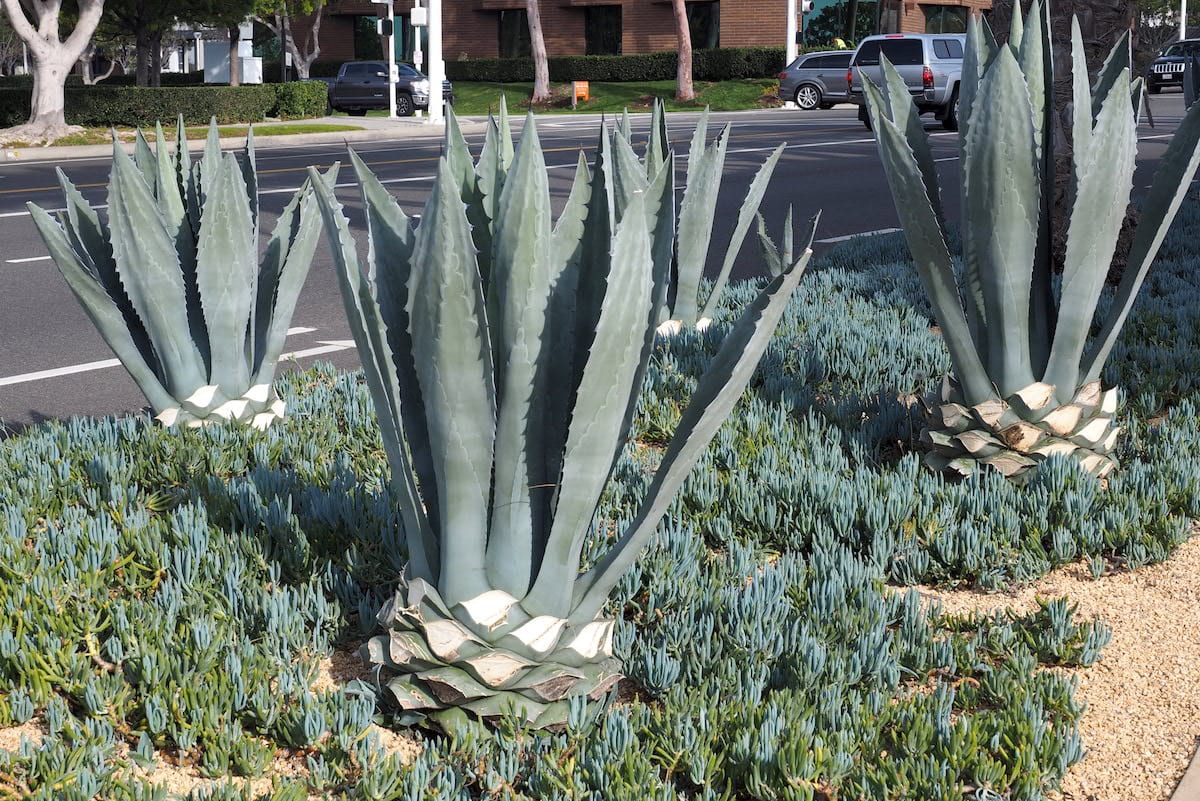
Trimming century plants like pineapples removes problematic foliage, but they plants will pup regardless
These large agaves’ thick leaves are wickedly toothed along their margins and tipped in sharp spines. I suspect that after a few years, century plants began encroaching on walkways. The need to prune some of them likely led to the aesthetic decision to trim all of them so they'd look the same.

As shown in my YouTube video, “Do’s and Don’ts of Growing Century Plants,” Agave americana produces pups (clones of the mother plant), which in turn spawn grandpups.
En masse these chopped agaves resemble a pineapple plantation, but that doesn’t offend me. What does, is that agave leaf pruning and pup removal are labor-intensive. Moreover, many municipalities won’t accept agave green waste—the plants are too fibrous, spiny and slow to decompose. I’m curious how thousands of sliced-off century plant leaves, each nearly as large as its machete-wielding gardener, have been (and will continue to be) disposed of.
Agave alternatives
There do exist large, statuesque agaves that are not especially treacherous and don’t pup like feral dogs. Two that would have worked well here (had it been possible to source them in quantity) are Agave guiengola and Agave ovatifolia. But using better-behaved agaves is only one alternative. Also from the Southwest US and Mexico are low-maintenance, low-water succulents such as yuccas, dasylirions and hesperaloes. They’re dynamic planted in multiples and don’t bloom-then-die like agaves do.
If I were to give the Newport Beach Civic Center’s succulent garden a letter grade, it would be a C+. I’d like to give it higher, but online info indicates that numerous large and expensive specimens (like Aloe thraskii, a tree succulent) that had been planted early-on, died. Perhaps they couldn’t tolerate being transplanted or were sited incorrectly. Regardless, my sad conclusion is that inadequate horticultural research prior to the installation of this grand succulent garden wasted time, taxpayers’ money and potentially terrific plants.
Related Info:
On this site…
Succulents for Coastal Southern CA Gardens (plant list)
No-Water Succulents for Southern CA (garden of Mark and Cindy Evans, Laguna Beach)
Watch my video about the pros and cons of a large succulent that’s often free:Agave americana

“resiniferatoxin” ?! I just planted one of these last year in front of our house. Luckily my kids are older and will actually love the fact that something growing in their yard is “4.5 million times hotter than a jalapeno”. Great article.
Yep. It’s an unassuming succulent that should be sold with a warning label!
Great article! It reminds me of another public place that put a cat’s claw acacia near a sidewalk and a house flippers in my neighborhood who put a big scratchy agave next to the walkway from the driveway to the house.
Yes, lots of that sort of thing going on. And in my own neighborhood (which is where most of the photos in my “What you need to know about Agave americana” video were taken). https://youtu.be/KBs-Hqbq48U
Hi Debra, Loved your commentary. You are terrific and you do know your…..stuff. You would think they used a landscape architect, or not. A husband and wife I know, both educated as landscape architects, left the field for lack of jobs. Hope someone in power sees your video. Keep up the good fight!
Thank you, Bivian! I stuck my neck out on this one, so a positive comment coming from you (president of the Laguna Woods garden club) is much appreciated. They hired a renowned landscape architectural firm from out of the area. Perhaps the firm was new to the installation and cultivation of these particular plants. What a huge difference that makes!
Hi Debra,
I agree with your critique. I think people forget about practicality of cactus spines and succulent sap.
Its one of those things where you would think the garden designers would of course consult a well known local, but they just did what they wanted.
Your email is perfect because others out there will make note of this. If no one ever says anything because they don’t want to shake up the system, we just get more of the same.
Thanks!
Thanks, James. No doubt a local design firm would have known better. Newport Beach has THE ideal climate for succulents! You can practically throw cuttings over your shoulder and they’ll grow. Such potential. I hope this doesn’t discourage the city from revamping the garden as time and funds permit. Its design mishaps are not the fault of the plants.
Debra, you are so right. Can I share what what my husband calls the whole complex? Taj-ma-City-Hall. The Agave are just the start. You haven’t mentioned the huge lawn next to the parking lot! When all the Residents down the street are prohibited from watering, this huge lawn, many times when it’s been raining, has it’s sprinklers going.
Thanks for taking the time for pointing these things out, as citizens, they don’t listen to us.
I did wonder about that immense lawn, but I saw photos online of gatherings that filled it, so I figured it has a purpose. For outdoor events, sometimes only a lawn will do. But to water it when it’s raining…?!
Dear Debra,
I really appreciate your critique of this garden. I’m a landscape architect and one of the biggest problems I’ve noticed in the landscape design field is the use and specifications of plant material that is either poisonous or sharp in areas where people are likely to come in contact with these plants.
The planting of Agave americana and some of our other large agaves next to paths or in narrow parkways is a passive aggressive act at the very least. Euphorbia such as ’Sticks on Fire’ and the green version are not only poisonous but the plants become large size trees when they mature.
Please keep up the good work. You have a great forum for educating the public and the knowledge to get the message out.
Thanks,
Anne Jones – RLA CA 5999
Viriditas Design
Landscape Architecture
viriditasdesigngroup@gmail.com
Thank you, Anne. Good point. As beautiful as it is, Euphorbia tirucalli, both the species and ‘Sticks on Fire’, have milky sap that can send the unwary to the hospital. Come to think of it, when those colonies of Euphorbia resinifera eventually have to be cut back from the pathway (they grow glacially), I sure hope the maintenance crew takes precautions. Yikes.
Debra, thank you. The critiques are invaluable especially with suggestions of alternatives. I see those mistakes over and over again. When driving by, I have to stop myself from stopping and telling the home owner to remove or move the problematic plants. I loved your description of the burn power of Euphorbias. I think they should come with a warning statement.
One of my favorite succulent gardens is near the Orange Coast College Horticulture Dept. where Joe Stead is employed. The dry stream bed is fantastic. That horticulture dept. deserves some publicity.
Thank YOU, Tina. Euphorbias can be used beautifully, but like any plant they have drawbacks. I’m aware of Joe’s garden at the college. It’s worthy of being a destination garden in its own right. I love how he grouped succulents from different regions. It’s beautiful AND educational!